Articles
- Page Path
- HOME > Korean J Community Nutr > Volume 17(1); 2012 > Article
-
Original Article
- Vitamin A Intakes and Food Sources of Vitamin A in Female University Students
- Jee-Young Yeon, Yun-Jung Bae
-
Korean Journal of Community Nutrition 2012;17(1):14-25.
DOI: https://doi.org/10.5720/kjcn.2012.17.1.14
Published online: February 29, 2012
Department of Food and Nutrition, Sookmyung Women's University, Seoul, Korea.
1Department of Food and Nutritional Sciences, Hanbuk University, Gyeonggi, Korea.
- Corresponding author: Yun Jung Bae, Hanbuk University, 233-1 Sangpae-dong, Dongducheon-si, Gyeonggi-do 483-120, Korea. Tel: (031) 860-1445, Fax: (031) 860-1449, byj@hanbuk.ac.kr
Copyright © 2012 The Korean Society of Community Nutrition
- 411 Views
- 0 Download
- 1 Crossref
Abstract
- The purpose of this study was to estimate the daily intake of vitamin A in Korean female university students. Vitamin A intake was estimated using an inconsecutive 3-day dietary intake survey from 481 young women. Vitamin A intake values were calculated based on the data in USDA database. Average age, height, and weight of the subjects were 20.05 years, 162.13 cm and 54.38 kg, respectively. The subject's average intake of energy was 1645.67 kcal. The mean vitamin A, retinol and β carotene intakes were 908.35 ± 863.18 ug retinol equivalent/day, 199.19 ± 166.00 ug/day and 3872.59 ± 4972.17 ug/day, respectively. The 21.83% of the subjects consumed less than the Estimated Average Requirement (EAR) for vitamin A. And subjects consumed 141.69% of the Recommended Nutrient Intake (RNI) for vitamin A. Food groups consumed with high vitamin A content in our subjects included vegetables (423.96 ug RE/day), potato and starches (213.64 ug RE/day), cereals (62.60 ug RE/day), eggs (55.17 ug RE/day) and milks (53.45 ug RE/day). The major food sources of vitamin A were sweet potato, carrot, spinach, egg, and cereal, and the top 30 foods provided 89.57% of total vitamin A. Also animal-derived food provided 9.65% of the vitamin A intake from the top 30 foods. In conclusion, judging from RNI, the vitamin A intake of the Korean female university students in this study was generally adequate. The result of our study may be used as a basis for follow-up studies of vitamin A intake like assessment of vitamin A nutritional status or evaluation of carotenoid food sources in Korean young women.
- 1. Bae YJ, Kim EY, Yeon JY, Cho HK, Lee JS, Kim MH, Kim MH. Evaluation of dietary behavior, nutrient and food intake status, and dietary quality based on Diet Quality Index-International (DQI-I) in female university students. J East Asian Soc Diet Life. 2010; 20(4): 491-501.
- 2. Bae YJ, Kim MH. A study evaluating nutrient intake and diet quality in female college students according to coffee consumption. J Korean Diet Assoc. 2009; 15(2): 128-138.
- 3. Hiraoka M. Nutritional status of vitamin A, E, C, B1, B2, B6, nicotinic acid, B12, folate, and beta-carotene in young women. J Nutr Sci Vitaminol (Tokyo). 2001; 47(1): 20-27.Article
- 4. Institute of Medicine, Food and Nutrition Board. Dietary Reference Intakes for Vitamin A, Vitamin K, Arsenic, Boron, Chromium, Copper, Iodine, Iron, Manganese, Molybdenum, Nickel, Silicon, Vanadium, and Zinc. 2000; Washington DC: National Academy Press.
- 5. Kim HY. Influence of carotene supplementation on serum carotene and retinol levels in lacto-ovo-vegetarian and non-vegetarian women. Korean J Nutr. 1989; 22(4): 257-265.
- 6. Kim MH, Lee JC, Bae YJ, Cho HK, Kim MH, Kim EY, Hong WJ, Sung CJ. Nutritional status and diet quality of female college students by living together with or without parents. J East Asian Soc Diet Life. 2006; 16(6): 635-645.
- 7. Kim SH, Lee SH, Hwang YJ, Kim HY. Exposure assessment of vitamins and minerals from various sources of Koreans. Korean J Nutr. 2006; 39(6): 539-548.
- 8. Kimura N, Fukuwatari T, Sasaki R, Hayakawa F, Shibata K. Vitamin intake in Japanese women college students. J Nutr Sci Vitaminol (Tokyo). 2003; 49(3): 149-155.
- 9. Kwon YS, Kim HS. Vitamin A nutritional status determined by assessing dietary intake and serum retinol level among elderly adults living in Asan. Korean J Hum Ecol. 2004; 13(1): 75-84.
- 10. Ministry of Health and Welfare. In-Depth Analysis on the 3rd (2005) Korea Health and Nutrition Examination Survey - Nutrition Survey -. 2007.
- 11. Ministry of Health, Welfare and Family Affairs [MOHWFA]. Korea Center for Disease Control and Prevention [KCDCP]. 2009 National Health Statistics- The 4th Korea National Health and Nutrition Examination Survey, the second year (2009). 2010; Korea: Korea Center for Disease Control and Prevention.
- 12. Nagao A. Absorption and function of dietary carotenoids. Forum Nutr. 2009; 61: 55-63.
- 13. Noh HH, Kim YN, Cho YO. Intakes and major food sources of vitamins A and E of Korean adults living in Seoul and Gyeonggi province. Korean J Nutr. 2010; 43(6): 628-637.
- 14. Oh HM, Yoon JY, Cho SH, Yoon JS. Vitamin A and vitamin E status of diabetic patients and normal adults in Korea. Korean J Nutr. 2009; 42(4): 318-326.
- 15. Paterson E, Gordon MH, Niwat C, George TW, Parr L, Waroonphan S, Lovegrove JA. Supplementation with fruit and vegetable soups and beverages increases plasma carotenoid concentrations but does not alter markers of oxidative stress or cardiovascular risk factors. J Nutr. 2006; 136(11): 2849-2855.
- 16. Research Institute of Food and Nutritional Sciences. Phytonutrient Contents in Vegetable/Fruits/Legumes. 2009; Seoul: Yonsei University.
- 17. The Korean Nutrition Society. Dietary Reference Intakes for Koreans. 2010; Seoul.
- 18. USDA National Nutrient Database for Standard Reference. U.S. Department of Agriculture, Agricultural Research Service. 2010; cited 2011 April 04. Available from http://www.ars.usda.gov/nutrientdata.
- 19. Wintergerst ES, Maggini S, Hornig DH. Contribution of selected vitamins and trace elements to immune function. Ann Nutr Metab. 2007; 51(4): 301-323.
- 20. Yeum KJ, Lee YC, Lee KY, Kim BS, Roh JK, Park KS. The serum levels of retinoids, β-carotene and α-tocopherol of cancer patients. J Korean Cancer Assoc. 1992; 24(3): 343-351.
- 21. Zhou BF, Stamler J, Dennis B, Moag-Stahlberg A, Okuda N, Robertson C, Zhao L, Chan Q, Elliott P. INTERMAP Research Group. Nutrient intakes of middle-aged men and women in China, Japan, United Kingdom, and United States in the late 1990s: the INTERMAP study. J Hum Hypertens. 2003; 17(9): 623-630.
REFERENCES
Figure & Data
REFERENCES
Citations

- Content of Fat-Soluble Nutrients (Cholesterol, Retinol, and α-Tocopherol) in Different Parts of Poultry Meats according to Cooking Method
Ji Hyun Lee, Hee Na Lee, Jung-Ah Shin, Ji Yeon Chun, Junsoo Lee, Ki-Teak Lee
Journal of the Korean Society of Food Science and Nutrition.2015; 44(2): 234. CrossRef
Anthropometric measurements of the subjects
1) Mean ± SD
Nutrient intakes of the subjects
1) Recommended Nutrient Intake, 2) Estimated Average Requirement, 3) Mean ± SD
Evaluation of vitamin A intake by dietary reference intake (DRI)
1) Tolerable Upper Intake Level, 2) Recommended Nutrient Intake, 3) %
Retinol, carotenoids, and vitamin A intakes of the subjects
1) ug retinol equivalent, 2) ug retinol activity equivalent, 3) Mean ± SD
Daily vitamin A intake from each food group of subjects
1) Mean ± SD
Major dietary sources of vitamin A (ug RE) consumed by the subjects
Major dietary sources of α carotene consumed by the subjects
Major dietary sources of β carotene consumed by the subjects
Major dietary sources of β cryptoxanthin consumed by the subjects
Major dietary sources of lycopene consumed by the subjects
Major dietary sources of lutein/zeaxanthin consumed by the subjects
1) Mean ± SD
1) Recommended Nutrient Intake, 2) Estimated Average Requirement, 3) Mean ± SD
1) Tolerable Upper Intake Level, 2) Recommended Nutrient Intake, 3) %
1) ug retinol equivalent, 2) ug retinol activity equivalent, 3) Mean ± SD
1) Mean ± SD

 KSCN
KSCN
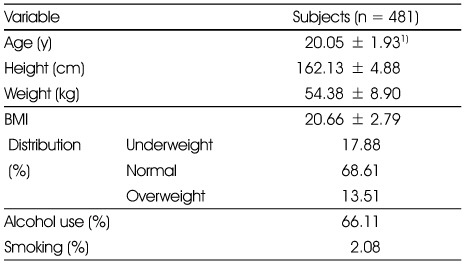
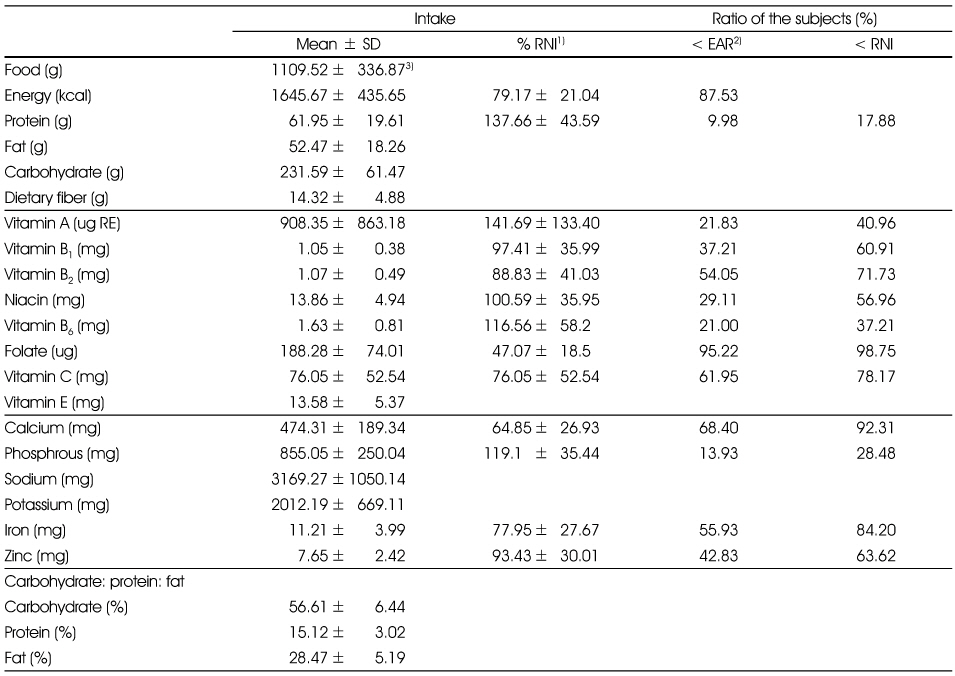




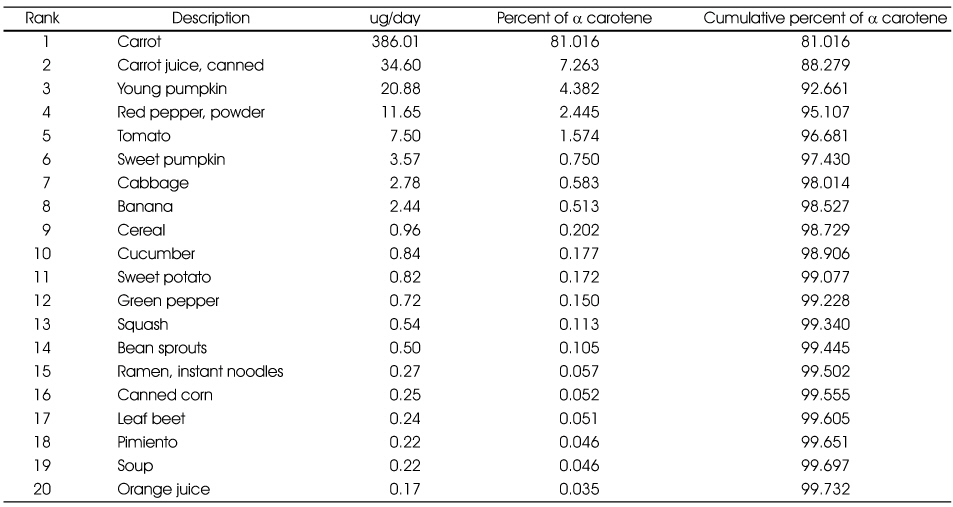
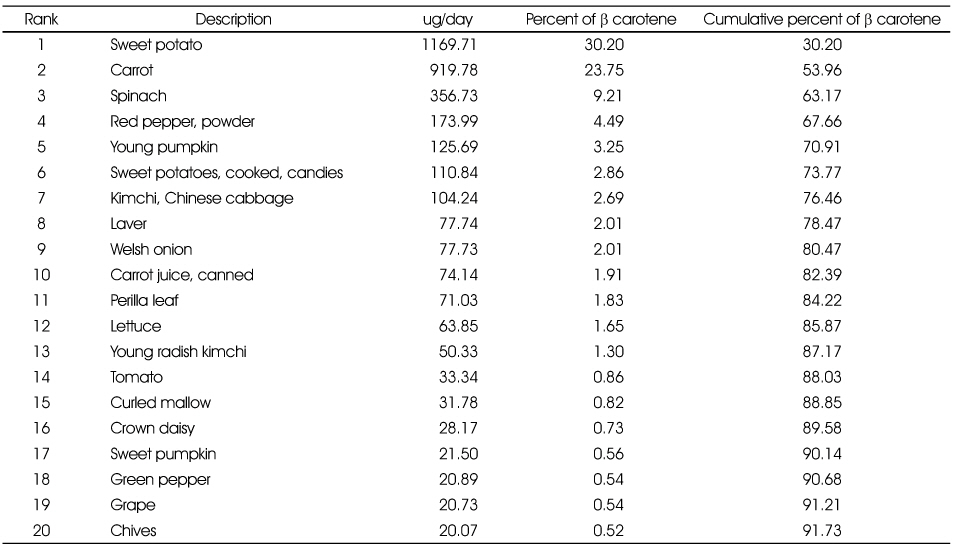
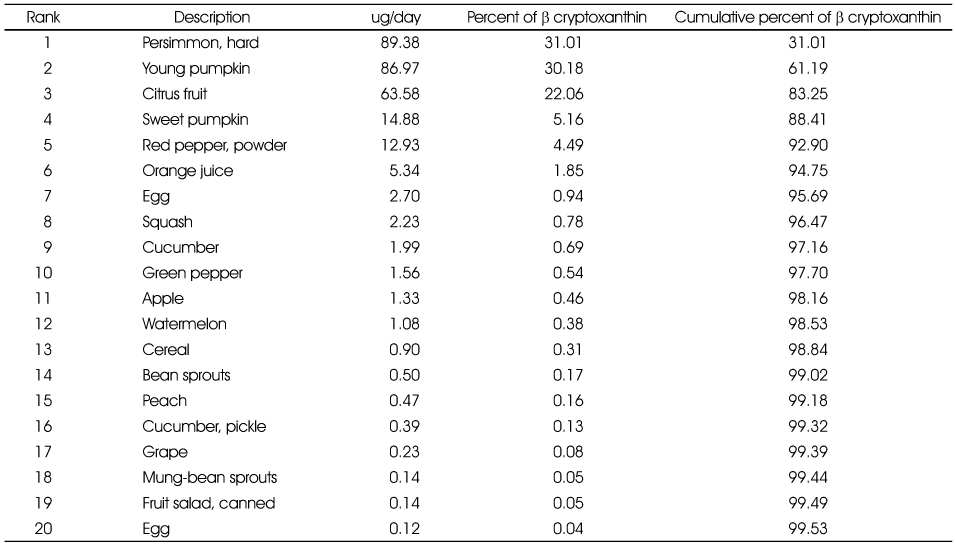
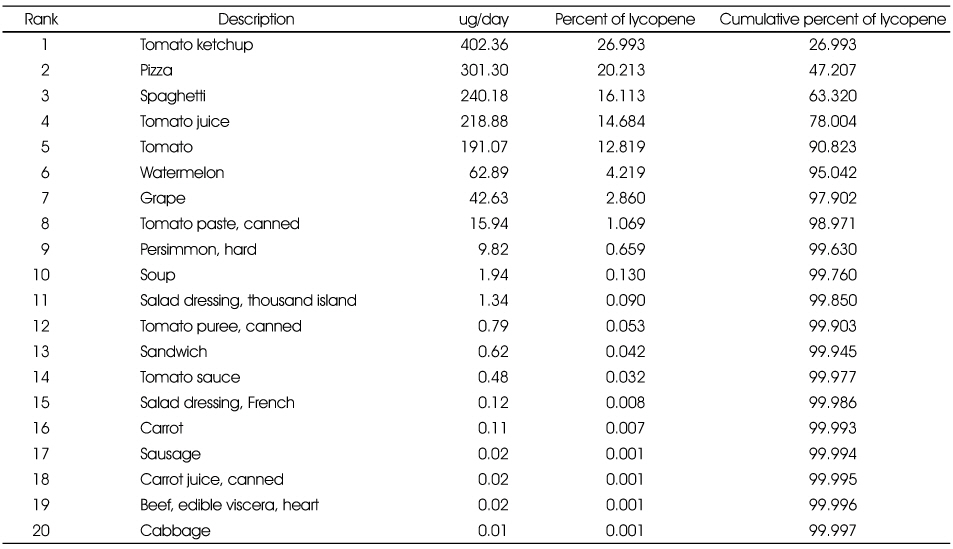
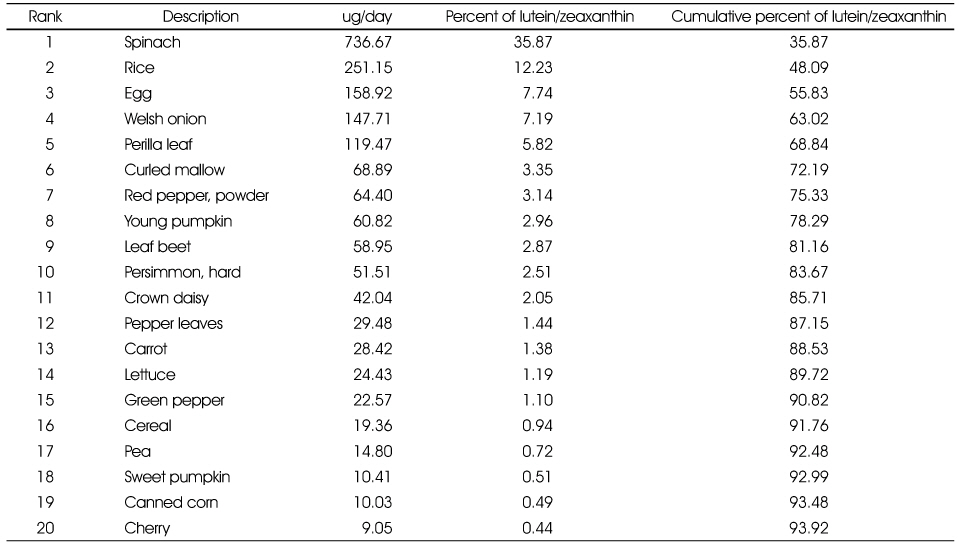
 PubReader
PubReader Cite
Cite


